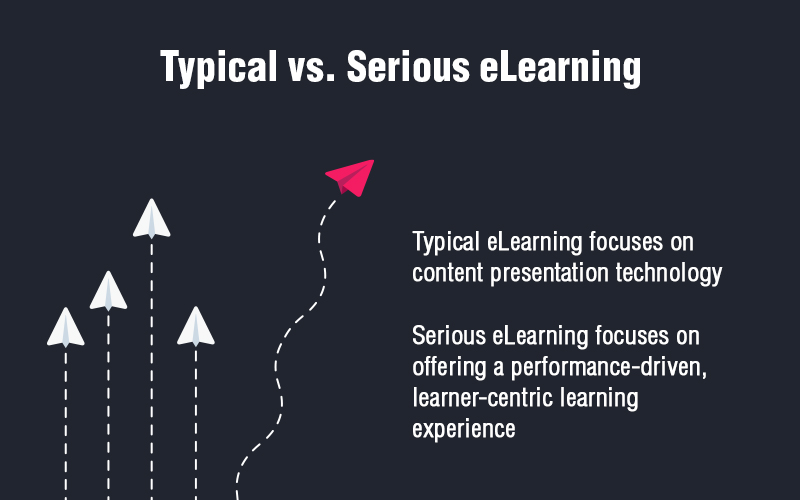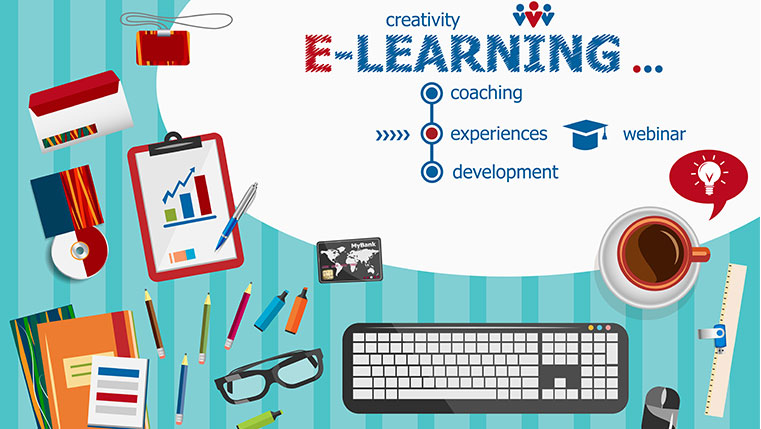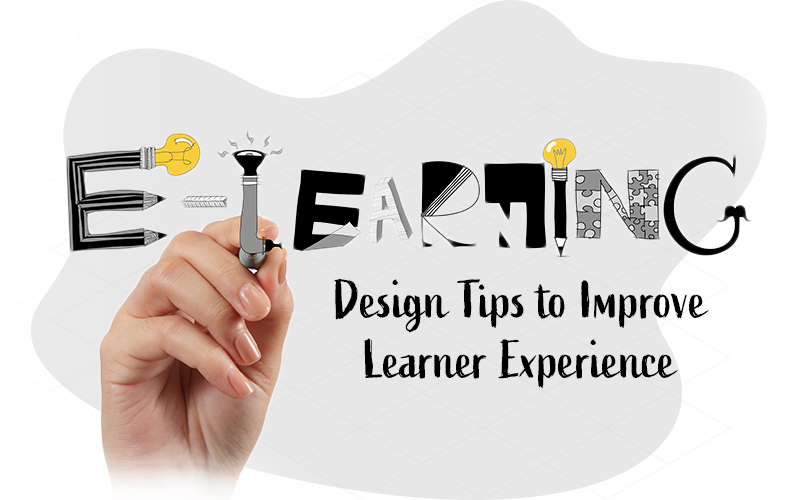Typical eLearning vs. Serious eLearning: What’s the Difference?

What exactly should an eLearning course look like? This is one fundamental question that we, as learning professionals, need to be asking. And by that, I am talking about all the design aspects that go into the making of eLearning.
Although eLearning is being used for a long time by organizations to train their employees, sometimes it fails to live up to its promise. And what is its promise? A performance-driven, learner-centric learning experience!
What is the Difference Between Typical and Serious eLearning?
In ‘typical’ e-learning, more importance is given to the presentation of the content and utilizing technology. Whereas, a ‘serious’ eLearning course has improving learner performance at the heart of its design, offering a performance-driven, learner-centric learning experience.
But in a typical eLearning environment, very little is being done to achieve that. This can happen due to many reasons, as we will discuss in this blog. But the bottom line is this: We need to go beyond typical eLearning and aim for serious eLearning.
Michael Allen in his book Guide to e-Learning offers a ‘Serious eLearning Manifesto’—a list of desired eLearning (design) values which highlight the differences between typical and serious eLearning. The Manifesto that can be viewed as a guide offering strong, pragmatic approaches to eLearning design has received widespread appreciation from researchers and L&D professionals.
Download this compilation of eLearning eHacks.
Typical vs. Serious eLearning – A Closer Look
So, what is serious eLearning and how is it different from typical eLearning?
Well, ‘serious’ eLearning is designed to improve learner performance. Unlike typical eLearning, it empathizes with the learner’s job needs and all the learning activities are designed around them.
Let’s go through some of the characteristics of each.
1. Content Presentation versus Focus on Performance
Typical E-learning: Typical eLearning focuses on the presentation of the content – making sure the training content is presented in an orderly manner –clear and complete.
And because most of the development time is taken up by content presentation, instruction is reduced to knowledge acquisition as opposed to building performance skills.
Serious E-learning: Serious eLearning is targeted toward offering performance-based learning – focusing on bringing about a change in the learner’s behavior and attitude.
The end product tends to be much more impactful than typical eLearning because it’s built around performance-driven, active learning experiences.
Right at the start of the course, performance-based learning objectives (LOs) inform the learner what to expect from the training and how it will help boost their work performance.
Learning activities are also aligned with these LOs to help learners acquire the required behaviors, attitudes, and skills.
2. Knowledge Delivery versus Authentic Contexts
Typical E-learning: Today’s eLearning authoring tools enable instructional designers to develop interactive learning experiences using videos, branching scenarios, learning games, simulations, etc.
But unfortunately, typical eLearning tends to focus merely on technology’s ability to deliver knowledge, and not on placing learners in situations resembling those they are likely to encounter at work.
Serious E-learning: The desired outcome of learning is the ability to do something the learner couldn’t do before. In many cases for this to be successful, learners need to be put in situations in which they can learn the salient aspects of a situation, react to them, note the consequences, and practice them until they can act with confidence.
Scenario-based Learning fulfils all these requirements through problem-based interactive virtual contexts.
Learners work their way through a problem scenario by applying their subject knowledge, critical thinking, prior experience and problem-solving skill in a risk-free environment, thus connecting the acquired knowledge with workplace challenge/s.
3. One-Size-Fits-All versus Personalized Learning
Typical E-learning: Every learner has different needs, interests, and learning paths.
Typical eLearning ignores these differences and forces learners to go through all the segments of the course even if some of them already have that knowledge.
In other words, it offers a one-size-fits-all learning solution.
Serious E-learning: Serious eLearning personalizes learning according to the learner’s current knowledge, job role, and needs.
For example, it creates a personalized learning path by applying non-linear design – giving learners the freedom to learn whatever best suits their needs and complete modules at their own pace.
Learners can jump into any section they believe will benefit and skip others that don’t.
In other words, it puts the learner at the center of the learning path.
4. One-Time Learning versus Spaced Practice
Typical E-learning: Typical e-learning takes the learner through topics sequentially – without any breaks –toward a final assessment at the end of the course.
It offers minimal opportunities for practice and uses a block of practice exercises that learners must complete at the end.
Instruction without a break leads to cognitive overload in the working memory, resulting in the information ending up in the short-term memory, likely to be forgotten within days.
Serious E-learning: Serious eLearning offers spaced learning – short repeated learning at regular intervals – to maximize knowledge retention.
For example, an hour-long eLearning course can be broken:
- By icebreaker questions before each module giving them space for reflection
- By summary slides between modules
- Into bite-sized microlearning courses (~5-10 minutes in duration) covering one learning objective at a time
5. Fact-Testing versus Realistic Decisions
Typical E-learning: Typical eLearning courses test memory and recall, using standard questions forms.
For example, multiple choice questions (MCQs), fill in the blanks, true/false questions, to name a few, have been a staple in eLearning for a long time now.
Though they test knowledge, these traditional assessments fall far short of testing the learners’ preparedness for their jobs.
Serious E-learning: Unlike the knowledge-based assessments of typical eLearning, serious eLearning employs performance-based assessments that are aligned with the performance-based learning objectives.
These assessments challenge learners to use their higher-order thinking skills to make realistic decisions and execute procedures as may be required in real life. This leads to the acquisition of new skills and an improved performance at work.
Some Final Words
As you can see, there is a stark contrast between a typical, one-size-fits-all online eLearning and one that is serious about boosting learner engagement and performance right from the word go. eLearning gives organizations one of the best shots at offering learners a valuable, meaningful training experience. But in order to leverage its full benefits, they ought to move away from the typical design approach to a more learner-centric, performance-driven eLearning design.
New-age learners are here – they want meaningful content, they want to be emotionally involved in their learning, and most importantly, they want learning that is relevant to their job task and will boost their performance. Will your eLearning meet all their needs? Download our eBook to check how you can ensure your eLearning courses address these elements.





